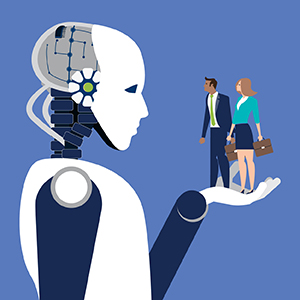Decoding insurtech lingo
Hype is everywhere about artificial intelligence for insurance applications, but that doesn’t mean it’s easy to implement. Not a computer scientist or seriously tech savvy? That doesn’t mean you can’t grasp concepts like artificial intelligence (AI) and machine learning and how they can operate in an insurance organization. To help explain these terms and their applications, let’s first start by defining them, then look at use cases in everyday life as well as insurance workflows.
What is artificial intelligence?
Lexico defines AI as: “The theory and development of computer systems able to perform tasks that normally require human intelligence, such as visual perception, speech recognition, decision-making, and translation between languages.” More simply, you can think of AI as a computer software which has the ability to think and learn.
What is machine learning?
IBM defines machine learning as “a form of artificial intelligence that uses algorithms to enable a system to learn from data rather than through explicit programming.” In other words, a human presents a set of data to the AI along with a method for interpreting the data. The AI learns from this method in order to form inferences about the data by itself.
Still confused? Let’s look at the various uses of AI and machine learning for insurance and daily life.
Artificial intelligence and machine learning in daily life
These new technologies are already part of your life:
- Email Inbox Sorting – When Outlook, Gmail, or other email applications automatically sort messages into categories, that’s done using AI and machine learning. The application uses data about the user’s behavior, common patterns in email messaging, and various other factors to maintain these distinct boxes. For example, the application can detect when an e-commerce retailer sends a promotional email vs. a transactional email, then delivers the email to the right folder in the inbox.
- Siri and Alexa – Siri was one of the first examples of a digital assistant to hit the mass market and is constantly learning based on how you use it. This means that whenever a customer orders a product or downloads a new app using Siri, or another digital assistant like Amazon’s Alexa, it will utilize this information in order to further personalize their experience. Based on the customer’s past and present actions, it may know whether they like opera or hip-hop, or whether they need apps on child rearing or retirement planning, then make recommendations which it infers are relevant.
- Spotify and Netflix – Spotify and Netflix, much like digital assistants, use AI to serve up what you like based on user data. Netflix also tailors the teaser image of videos to appeal to what you’ve seen before, such as an actor you like.
Machine learning and artificial intelligence for insurance
With the massive amount of data that insurance agencies and companies collect, the industry is well positioned to benefit from AI and machine learning in a way that many others can’t. In fact, many insurance companies are already leveraging them in the following ways.
- Claims Handling
Using AI photo analytics and estimating logic, claims estimators can quickly resolve claims more accurately. For instance, the AI can process a photo of vehicle damage and provide an estimate of the cost based on factors such as the size and orientation of a dent. Several insurance companies are using a similar combination of technologies to accelerate the process for claimants and optimize the estimation process in order to reduce associated hard and soft costs of claims overall.
- Online, Real-Time Quote & Bind
The traditional quote and bind process is time-consuming and error prone. Some insurtech platforms use AI to streamline the process and automatically generate a quote, helping underwriters and brokers save time and issue policies faster.
- Underwriting
Not everything can be underwritten using AI, but certain lines of coverage like travel insurance, event insurance, and car insurance are ideal early use cases because of their small scale and simple processing. Even when the process requires human intervention, AI can aid in almost every scenario, allowing underwriters to pull in external data in order to fortify their decision making and risk management.
WHERE IS ARTIFICIAL INTELLIGENCE FOR INSURANCE HEADING?
In the future, AI and machine learning will affect every part of the insurance industry, particularly underwriting, claims, and distribution, according to McKinsey. In combination with other technologies like automation and telematics, AI will enable insurers to analyze and price risk faster and with greater precision. The technology will also change how agents operate, with digital assistants helping streamline how agents sell to and interact with customers.
SEE MORE FROM THIS SERIES
- Insurtech 101: Robotic Process Automation in Insurance
- Insurtech 101: Pros and Cons of In-House and Off-The-Shelf OCR
- Insurtech 101: Blockchain for Insurance
Not sure where to start? Check out how ReSource Pro is leveraging its digital capabilities to create more efficient, user-friendly insurance processes.




